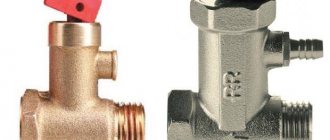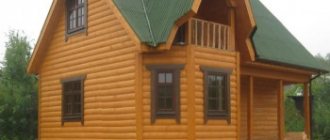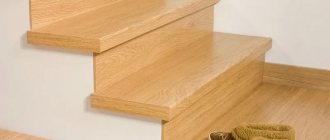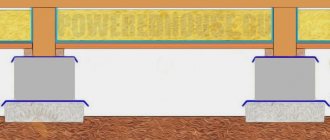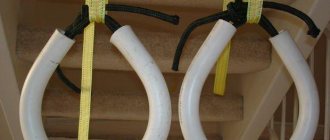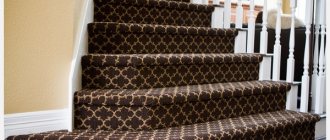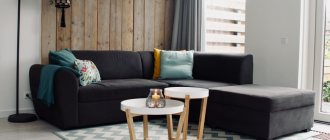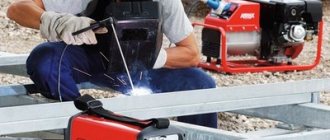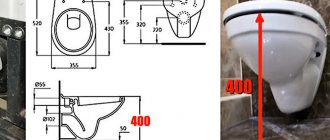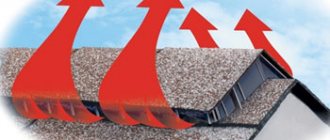When designing their home, all developers think through the best options and the most rational location for constructing the staircase, the size of its steps and the materials acceptable for this. Of course, the minimum area is occupied by the corner stairs to the second floor.
Numerous samples in this article will help us successfully select the type, as well as the width of the flight, the depth and height of the steps, and decorative elements: using them we can easily clarify the parameters and consumption of specific materials.
Wooden lightweight and reliable corner staircase structure
The successful arrangement of the staircase and appropriate placement will make it an effective element of the interior in a small cottage, and in a spacious living room it will be a respectable and decisive accent of the room.
DIY wooden staircase to the second floor
Installing a wooden staircase with your own hands is a labor-intensive and quite complicated process for a beginner, as it requires certain training, skills and abilities.
It is obvious that securely fastened and perfectly adjusted staircase elements make the structure as stable and reliable as possible, eliminating creaks, swaying and deformation. However, novice craftsmen often neglect simple rules, which leads to distortions, premature destruction and other extremely unpleasant consequences.
In this article we will try to talk about the key points of assembling and installing rotary flight stairs so that you do not make mistakes in practice.
If you don't have a finished project, we recommend that you use our online staircase calculator .
It allows you to receive a ready-made estimate, a set of drawings, a 3D model and recommendations for manufacturing the most convenient design.
What are the angles?
First, let's look at how each type differs.
- Up to 30° flat surfaces and ramps;
- 30-45° are household;
- 45-75° attached.
- More than 75° for household needs, for evacuation, firefighters, which are fixed on the walls of buildings.
The number of steps in the flight of flights will depend on the slope and height of the interfloor ceiling. The optimal number value is 3-17 . There is one peculiarity here. It is recommended to make an odd number. This is necessary in order to finish the lift with the same leg with which it started. For the majority of people, this feature is the most convenient.
Introduction
Installation of a staircase, like any other structure, is carried out in stages. First of all, parts are always installed that perform the function of load-bearing elements and access to which will be difficult in the future.
However, each master has his own exact sequence of assembling individual elements, and any of these methods does not claim to be the only correct one.
To avoid asymmetry, after each stage of work, check with a level that the horizontal and vertical projections are observed.
Wood grain direction
When manufacturing staircase elements, you should pay special ATTENTION to the direction of the wood grain . Drawings must be transferred to the source material, taking this feature into account, along the greatest direction of the template.
Wood has such a quality as anisotropy - that is, its physical and mechanical properties differ depending on the direction within the medium. For example, the compressive strength of wood along the fibers is 3-4 times greater than across the grain, the tensile strength is more than 30 times greater, and the indicators for fracture and chipping are similar. Professional carpenters know these nuances and produce products in accordance with certain rules that allow them to achieve the highest possible reliability of the final product.
For example, the winder step at the junction with the turning post has a rather small support surface, as a result of which an increased load is applied to this place. If the wood fibers are located parallel to the front edge (that is, along the larger side), the load is distributed evenly over the entire element , and if perpendicular, then near the attachment point, a break will soon occur along the direction of the fibers in the narrowest place.
The situation is similar with stringers in places where steps are cut - the direction of the wood fibers must be parallel to the upper and lower edges of the board. Otherwise, unreasonable arrangement of fibers will definitely lead to the appearance of a defect.
Source
Independent calculations using the method of proportions
They say if you want everything done well, do it yourself. Therefore, independent calculations of the amount of materials, searching for the right angles and calculating strength are necessary for your own peace of mind. Confidence that the structure will withstand extreme weight and last for many years.
Step-by-step calculation of a staircase with winder steps at 90 degrees:
- In the drawing, a circle is drawn with a diameter equal to the width of the flight of stairs. This is how the running section is planned.
- A line is drawn from the upper left corner through the center of the circle at an angle of 45 degrees. This will become the axis of rotation.
- It is necessary to outline a vertical line entering the circle from below and exiting horizontally from the right. This is the driving route.
- Next, the entire line of movement is divided into segments that are equal to the width of the step. On straight sections these will be ordinary segments, and along the circumference – chords.
- Two straight marches are completely drawn along the planned segments. It should be remembered that part of the straight steps adjacent to the circle will subsequently change.
Calculation of winder steps Source olestnicah.ru
- The outer edges of straight marches must be connected by lines forming a right angle. This part is responsible for the running section.
- A line is drawn parallel to the horizontal route and a line parallel to the vertical one. These lines are drawn along the edges of the steps, which will not be modified in the future. And at the intersection point A is marked.
- Lines are drawn from it that will intersect all the extreme points of the segments and chords along the line of motion.
- After this, you can select the contours of the winder steps.
Now all that remains is to scale and find out the exact dimensions of each part. It is better to draw on lined graph paper. This will allow you to easily convert the dimensions of the selected material to actual size. But experts note that graphical constructions cannot be compared exactly with computer calculations.
What materials are used to install stairs inside the house?
Flights of stairs installed indoors do not require such serious staircases as if the steps of the stairs were to be installed outside the building. In the second option, the porch is constantly exposed to harmful factors; the stairs are damaged by precipitation, solar ultraviolet radiation and temperature changes. This can be avoided by completing a turnkey installation of a concrete staircase or by resorting to installing a structure on a metal frame. Stairs made of brick, aerated concrete blocks, natural and artificial stone have also proven themselves well on the street.
Programs for calculating stairs
There are many programs for calculating stairs. Using a specialized resource, you can create a drawing of a staircase and visualize the structure. The following software packages are especially popular:
- Compass is the most common service;
- Solid Works is used not only for stairs, but also for various engineering structures;
- Cosultec Staircon allows you to create a project, as well as provide an estimate for its construction. A three-dimensional model allows you to see what the future structure will look like.
Online builder option
What is a two-flight staircase, and why are they so popular?
As already mentioned, in rooms of sufficient area and correct geometry, it is better to use flight stairs (ideally for one flight) to organize movement between floors. If you are experiencing a shortage of this very area, make a turn 90 or 180 degrees, and the problem will be solved. Thus, a two-flight staircase with an intermediate platform between flights of stairs allows, first of all, to save space.
In addition, with the right approach to installing steps on concrete, this is also ideal from a design point of view. It remains to be seen how safe this design is. In this regard, such a solution is also considered correct, since, unlike spiral staircases, it is more comfortable to move along marching products, since all steps have the same shape and size, with the exception of turning products.
Photos of various staircase designs
When designing independently, you need knowledge about one or another type. In private construction, marching types, screw or on bolts, are often used. The materials used are wood, reinforced concrete, stone or metal.
So, before we start designing stairs online, let's take a closer look at each type.
Screw
This option is popular in private homes. Moreover, its arrangement does not require a lot of usable space. The staircase consists of steps, a rack and handrails. Screw structures can be not only round, but also square or even octagonal.
The staircase most often has a metal frame, but there are also completely wooden models. You can see what screw types look like in the small photo gallery below:
On the stringers
Staircases on stringers are also often used. They are distinguished by high safety, sleek appearance and many decorative options. They are made both with and without risers. The method of fixing the steps depends on the number of beams that are mounted to the base.
The photo below demonstrates what kind of original design can be created if you take a traditional model as a basis.
Option on one stringer
Construction on broken stringers
On the bowstrings
Such designs have a sophisticated appearance and are perfect for classic interiors. The steps are fixed to the support beams from the inside. Such products are made of wood or metal.
Wood construction on bowstrings
On the Bolts
These stairs are often made of metal, but combined options can also be used. All elements are fastened with bolts and pins, so they are durable and strong. The support beam is fixed to the floor using metal rods. The advantage of the design is the possibility of its reconstruction and disassembly.
Lightweight bolt-on design
Marching
Marching models are popular due to their simple design. To arrange them, a free space of about three meters is required. To save space, rotating flight stairs with intermediate platforms are used.
In private construction they are made of wood, stone, concrete or metal.
We hope that our article will help you choose convenient methods and programs for calculating stairs. Using the correct calculations will help you get a well-executed project and drawing, as well as build a strong and reliable structure. If you want to share your experience, write in the comments.
Which stair cladding to use indoors
Correct installation of a staircase inside a house is not only about the correct technology and materials for constructing the supporting structure, but also about high-quality cladding. It must correspond to the chosen design style, while it is important to remember about safety, because how many steps even inside the house can cause a lot of trouble, not to mention the installation of a slippery concrete porch on the street. There are many options for covering steps:
There are still many materials on the construction market that can be used to finish staircase steps. Each of them has its own advantages, and they also have disadvantages. Meanwhile, there is a relatively young C3 technology for cladding stairs, which has in many ways surpassed its competitors.
Briefly about the main thing
When the small area of the room does not allow installing a straight flight of stairs at the required angle, then a more compact design can be used. A staircase with winder steps will fit perfectly into any interior and perform the functions of a lift no worse than other structures. And most importantly, it will save space and provide a comfortable lifting angle.
But in order not to spoil the design of the room, you need to choose a decent model. After all, the same staircase can look completely different. This also applies to materials that will be involved in construction and design solutions. But the most important thing when choosing such a complex structure is competent calculations. They are either performed independently or entrusted with the work to specialists.
Ratings 0
Features and advantages of installing stairs using C3 technology
One of the advantages of this innovative technology for installing stair cladding is the ability to cover different surfaces - wood, metal, stone and concrete, of course. Speaking about the advantages of C3 stairs, I would also like to mention:
Despite the fact that the steps of the stairs inside the house are not subject to harmful influences from the outside, you should never forget about the safety of step structures. They should not slip, so it is better to avoid glossy coatings. You can make the steps non-slip using overlays and other means, but why waste time and money if the cladding of stairs using C3 technology never slips, and this does not require extra investments. The cladding has a pronounced structural surface and differs from its competitors by the presence of a relief pattern. By the way, the price of installing stairs and cladding using C3 technology is considered affordable, especially considering the decades of operation, as experts involved in the development of this unique technology have unfoundedly stated.
Video about the features and advantages of C3 stair cladding technology:
Source
Customer reviews:
Pros: Good day! I “accidentally” visited your site and... got great pleasure from seeing so many very interesting stairs. Comment: Thank you! With uv. Victor April 07, 2020 Victor
View the range of our tools for the Summer / cottage / home. And also the tool is your best gift! Open sources were used: the Internet and social networks. We work with pleasure, Arsenal Masters RU Team. All Useful photo reviews "Arsenal Masters"
Characteristics of staircase parameters for a home
The rise to the second floor depends on the geometry of the premises of a private house. It can be straight, rotary or screw. The straight shape is the most convenient for moving people, carrying large objects, and is easy to calculate and install. But with a standard 3 meters between floors and a span width of 1 m, it requires a minimum of 10 m2 of space on the ground floor, which is not available in every room.
Due to turns, the length of the opening for L- and U-shaped structures is shorter than for straight ones, although both types occupy almost the same area. Platforms or winder steps are installed on turning areas.
The steps make the turn of 90 and 180 degrees smoother, reduce the steepness and size of the stairs, but the winder steps are less convenient than the landings. L- and U-shaped marches are placed along the walls, in the corners, and the space under the stairs is used for storing things or as a resting place.
To calculate a convenient staircase to the second floor, during construction you need to follow the basic design standards:
Staircase in a private house as an important element of planning convenience
When choosing a material and design, you must be guided not only by aesthetic preferences, but also by remembering safety and ergonomics. The following criteria will help you choose the right design and materials for the stairs:
- the location matters - in the center of the hall or as a secondary option in other rooms;
- dimensions and area for staircase construction;
- design safety level;
- the thickness of the walls to which the staircase will be mounted;
- the surrounding interior in the room where the structure will be located.
Ladder design diagram
There are special requirements and SNiP standards that must be observed. Before work, drawings and calculations are performed. For ease of calculations, various online staircase calculators are used.
The following technical requirements should be taken into account:
- load-bearing walls must support the staircase structure;
- the supporting parts must be installed at a certain angle and on a special surface;
- it is important to maintain the recommended distance between steps;
- the railings must withstand a certain load of 400 N;
- it is necessary to maintain the correct distance between the bowstrings;
- there must also be the required distance between spans;
- the marches must have a gap and the same slope.
Main constituent elements
The main structural elements can be seen in the table below:
| Important components of a staircase structure | What can they consist of (options) |
| Basic structure | Bowstrings are side elements that support steps from the ends and bottom. They look like curved beams. Installed at an angle. Stringers - support the steps at the bottom. Bolts are special bolts that help secure the steps and walls of a building. The support for the screw structure is a vertical stand on which all the elements are fixed. Load-bearing parts can be made of different materials. |
| steps | The steps can be arched, winder, beveled or straight. The staircase can be two-flight or multi-flight. In this case, a step is mounted between the marches. |
| Fencing | Guardrails guarantee safe movement. These include the following elements: The baluster is a vertical post that supports the railing; Railings are used to fence marches and platforms; A handrail is an inclined element of a railing that is fixed to the balusters. Sometimes handrails can be mounted to the wall |
Related article:
Stairs to the second floor in a private house. A detailed overview of existing types of stairs and practical installation instructions in a separate material.
Frequently asked questions about staircase design
The simpler the design, the easier the calculations and the greater the likelihood that you will be able to build a successful structure. In this regard, the ideal solution is a straight single-flight staircase. You need to know the dimensions of the ceiling opening, calculate the span length (height between floors plus the thickness of the floor beam, floor covering), calculate the slope and tread depth. We recommend wood as a material. If there are inaccuracies in the calculations, it is easier to adjust wooden parts to the required dimensions (unlike concrete or metal).
Comfortable slope values
The most comfortable angles for stairs are 40-50°. However, structures with such values are bulky and are used in large buildings. Designs with values of 30-36° are compact in size, but not comfortable. It will be comfortable to go up, but not too much to go down. Before calculating the staircase, it is worth studying the entire space of the room in which installation is planned. It must be used rationally. That is why you should design a structure that will occupy a minimum of space. If you plan to install more than 3 steps, then you will have to install railings. The width of the steps should be 28-30 cm, height 15-18 cm. Moreover, if they are all the same size, the safety of use increases.
Construction of a wooden staircase
A wooden staircase for a private house most often consists of one or several flights (flights), which are located between floors or intermediate platforms.
Construction of a wooden staircase
The design of a flight of stairs is a combination of various components with different functional purposes:
Ideal angles
The slope of the span is most often 20-50°. The most ideal would be 30-45 degrees. However, not everyone will have enough space in their home to create such a structure. However, it is worth considering that the smaller the slope created, the more dangerous it will become to move. At large values, the structures will be bulky. It is almost impossible to comfortably navigate stairs with an angle of more than 45°. You can only go down it safely with your back down. It will be dangerous for children.
Types of staircase designs
When choosing a staircase structure, the main factor is the size of the area required for its construction. In second place is the convenience and comfort of ascent and descent. Here you need to take into account the frequency of use, the presence of children and elderly people in the house.
Aesthetics is also an important criterion. The staircase should be combined with the interior of the room. In addition, it is necessary to take into account material possibilities: the production of wooden stairs with a complex configuration requires more time and financial costs than options that are simpler in form and execution.
Marching
Are the most popular. They got their name thanks to marches (flights) - a group of united steps. The staircase may have one or more flights.
There are straight structures (single-flight and double-flight, with a rest area). They can be free-standing or placed near the wall. But straight models require a lot of space, so in order to save useful space, two-flight options are provided with a rotation at an angle from 90 to 180 degrees.
The flight has a curved shape with an optimal angle of elevation, then rotary steps are used, which are also available in structures with two and three flights without platforms.
The most popular types of wooden stairs for a country residential building are:
Screw
Screw-type structures are used less frequently, as a rule, with limited space or for aesthetic reasons by the owner of a private house. They are not as convenient as marching ones, and it is difficult to transport furniture on them. To install the ladder, you will need to perform complex calculations, since with a small error it may lose its functionality.
Spiral staircases sometimes serve simply a decorative function, especially with a fence made of artistic forging. The installation of such options is possible in almost any room, because they take up less space than rotating designs. The following types are distinguished:
Determining the required geometric dimensions
In order to correctly perform calculations, it is necessary to take into account certain geometric measurements. According to experts, three parameters are mainly important:
- height is the distance from the floor surface on the first floor to the floor surface on the second. To correctly determine the distance from the step to the ceiling, you need to take the height of the tallest person in the family and add 100 mm;
- the length is equal to the length of the march or the sum of all marches. At the same time, a staircase is added between them;
- width - the distance of the structure from the wall or the gap between two handrails.
In the diagram you can see the relationship between the angle of inclination and the steps
It is necessary to take into account the width of the marching structure:
- 1÷1.2 meters – will ensure comfortable movement;
- 1.5 meters – high level of comfort;
- 0.8÷1 meter can be used for a ladder installed against a wall;
- less than 0.8 meters - for auxiliary models.
Example of calculated data
The minimum permissible width for stairs with winder steps is 1.1 meters. The width cannot be less than 1.1 meters for a screw structure. The comfort zone starts from 1.4 meters.
The video below shows a simple way to calculate stairs:
Stair inclination angle (steepness)
The angle of inclination determines the ease of use of the stairs. A staircase that is too steep allows you to save useful space, but a flat one makes moving along it more comfortable. The type of staircase depending on the steepness is shown in the photo below. Here you can clearly see at what angle the staircase in a living room should be. The most comfortable option for movement is in the green one.
The diagram shows different angles of inclination
For your information! A staircase can be placed in a residential area only if the premises on the first and second floors are heated. If not, then the installation is carried out in a non-residential premises.
An example of calculating the length, calculating the height and width of staircase steps in a private house
One of the most important points is the correct calculation of the steps of the stairs. The dimensions should be such that it is convenient to move along the stairs. It is necessary to determine exactly what the height and width of the staircase steps should be.
The height of the step should not be too small so as not to disrupt the step. The optimal indicator varies between 150÷180 mm. The width of the tread should be such that the sole fits completely on it. The optimal option is from 250 to 320 mm. Often the tread is made with an overhang over the bottom step.
To find out the optimal ratio of width and height, you can use the following relationship:
2h + b = 600÷640 , where
- h – step height;
- b – tread width;
- 600÷640 – the approximate length of a human step, or rather its average value.
Recommendations for step sizes
The disadvantage of the formula is that it does not take into account that the step width can be smaller or larger, and also does not take into account the slope of the march.
Step standards
To calculate the steps of the stairs to the second floor more accurately, use the special online calculator below, which uses other formulas.
Method of trigonometric calculation of step sizes
To determine the distance between the edges of the steps, the following formula is used:
G / sin 63° = (0.5 × L) / sin (27° + α),
Segment G is the hypotenuse in a triangle in which the legs are the width and height of the step.
From here:
- h = G × sin α= G × cos (90 – α);
- b = G × cos α= G × sin (90 – α).
But to find out the dimensions, it’s easier to use an online calculation of staircase steps.
Calculator for calculating the optimal sizes of steps of a flight of stairs
A simple way to calculate steps is presented in the video below:
Determining the optimal angle of inclination of the stairs
Almost all stairs have a slope of 45 degrees. The width of the step usually corresponds to foot size 45, but it should not be less than 30 cm.
Let's consider the main angles of inclination:
- for household stairs, the angle varies from 30 to 45 degrees;
- for flat structures and ramps – 30;
- for attached and steep options – 45÷75;
- utility ladders – more than 75.
There is a certain relationship between the steepness of the staircase and the location of its installation. The following relationship is used for the calculation:
D = H / tan α , where
- D – length of the horizontal projection of the stairs;
- H – height of the flight of stairs;
- α – slope angle.
Calculator for analyzing the relationship between the angle of inclination of a staircase and the size of its horizontal projection
To correctly calculate the parameters of the staircase, use the online calculator above to analyze the relationship between the slope of the structure and the size of its projection.
You can carry out calculations in two ways:
- if you need to build a staircase with a specific angle, then the calculation will show what space should be allocated for it;
- if the dimensions for the stairs have already been determined, then you can find out the required angle of inclination.
If there is not enough space for a single-flight structure, then two flights are used. In this case, separate calculations are carried out for each of the marches.
Comfortable movement depends on the correct angle of inclination
Making a turning staircase with your own hands
To assemble the structure of a rotating flight of stairs with your own hands from wood, you must first calculate the dimensions of all elements. And based on it, calculate the nomenclature and quantity of lumber. The calculation is based on the space in which the staircase will be located.
Construction of a wooden staircase
There are so-called standard recommendation indicators for a turning staircase:
It is very important to take into account that there is such a parameter as the height of the passage. This is the size from the flight of stairs to the bottom of the ceiling - it should be at least 190-200 cm. Otherwise, you will have to climb the stairs in a half-bent position, which is unacceptable.
If a wooden staircase with a landing is planned for the house, then the dimensions of the latter are chosen depending on the width of the two flights of stairs.
Calculation of a turning staircase
It is convenient to calculate a wooden staircase with a rotation of 90° or 180° using free online calculators. After clicking on the link, select the type of structure you are interested in and perform the calculation.
Manufacturing and installation of load-bearing stringer beams
Let's look at wooden flight stairs built along stringers. Stringers are selected according to their load-bearing capacity, which is determined by the cross-section of the timber used. The optimal cross-section of the beam is 50x300 mm. And it is better if it is wood from durable species - beech, oak, larch. However, pine will also work.
In this case, the supporting beam must be prepared, made in the form of a comb. There are two ways to do this:
Option for making a stringer with fillies
The first option is used more often, since it is easier to carry out the work. The cuts are made with a regular saw or jigsaw. The cut planes must be further processed with sandpaper to create a smooth surface. The steps are cut from boards 4-5 cm thick, their dimensions and quantity are determined during the calculation process.
Manufacturing of steps and risers
The main thing is to maintain the dimensions of the stepped elements that were calculated on the calculator. But there is one point where you can save money. The riser does not bear any load. It is a decorative element. Therefore, there is no point in buying thick boards for him.
The thickness of the riser is always less than the thickness of the step
For example, if the steps require a board with a thickness of 40-50 mm, then lumber with a thickness of 20-30 mm is suitable for the riser.
Assembly of the structure
Let's look at step-by-step instructions for assembling a two-flight wooden staircase with a platform with your own hands.
Attaching the stringer to the floor
By the way, the installation of wooden stairs to the second floor of the U-shaped type (with a 180° turn) is practically no different from the installation of an L-shaped (with a 90° turn) version. The only difference is in the shape of the structure. And all construction operations and calculations are carried out the same way.
Options for fixing elements
The installation of stairs with winder steps differs in purely constructive positions. First of all, there is no intermediate platform, which means the winder elements must be attached to something. The same applies to the upper ends of the stringers of the lower flight and the lower ends of the support of the upper flight. There are several options, but more often they use support posts that are installed under the stringer edges. They also try to attach winder steps to them.
There is another option, when the upper stringer is extended to the lower one. There is a kind of connection between two load-bearing beams, to which steps and risers are attached at the turn.
Installation of balusters and railings
There are supporting balusters, which are what mainly hold up the railings, and there are intermediate ones that serve as fencing elements.
Fencing fastening scheme
In hardware stores you can find ready-made wooden railings and balusters that can be easily adjusted to the required dimensions in terms of their height. They are available with standard fasteners made of plastic or metal. There is no need to cut or adjust anything. Install the fastening element at the installation site, attach it to the load-bearing elements of the staircase structure and insert railings and balusters into them.
Source
Main technical parameters
In order to correctly calculate the stairs to the second floor with your own hands, you need to have an idea of the important parameters of such a structure:
- the angle of inclination should vary between 30÷50 degrees, and the best option is 45°;
- the width of the steps should be 22÷30 cm. The most comfortable option is 25 cm;
- riser height 15÷20 cm;
- railing height 90÷120 cm;
- minimum width – 80 cm.
Important technical parameters for staircase construction
The number of steps can be determined by dividing the height of the planned structure by the selected riser height. The slope of the stairs implies the ratio of the height of the riser to the width of the tread. To determine all these parameters, it is better to use special formulas or calculators.
Detailed staircase diagram
Span length calculator
It is extremely necessary to know the length of the flight span. This parameter will help you when ordering materials for handrails and stringers. The design length will provide the necessary margin. The calculation is made using the following formula:
L = √(D² + H²) , where
- L – length of the flight of stairs;
- D – horizontal projection length;
- H – horizontal projection height.
To calculate the stairs to the second floor, use the calculator below.
Calculator for calculating the length of the opening in the ceiling
An important parameter is the ceiling opening through which the flight of stairs passes. There must be a safe distance from any point on the staircase surface to the ceiling. To calculate the staircase using this indicator, a special online calculator is also provided.
The length of the opening is determined by the following relationship:
S = (V + P) / tan α , where
- V – passage height;
- α – march steepness angle;
- P – floor thickness.
How to calculate the slope?
It is best to calculate the length of an adult’s stride while walking calmly on a level surface. The inclination of individual flights should be calculated separately based on the number of steps and their height. If you have a ready-made project, it is easy to determine the slope. On the diagram you can see which ones are suitable for use and which ones will become undesirable.
As they said, the ideal height is 150-180 millimeters, width 280-300. If you apply these standards, then you can use the formula 2x y 580/660 mm, where x is the height of the steps, and y is the width. If the steps are less than 145 millimeters, then the formula x + y is applied. The formulas use a width equal to the size of an average person’s foot, and a height corresponding to the length of a step. To summarize, we can say that the lower the finished step, the wider it needs to be made and vice versa.
Installation of railings
To install balusters, small holes are drilled in the steps, with a diameter slightly smaller than the dowel for fastening, and coated inside with glue. The same groove is made in the center of the balusters. We stretch a rope along all the balusters to determine the angle of inclination of the handrails and cut off all excess. Now the balusters are ready for installing handrails on them. They are perfectly fastened with self-tapping screws, which can be beautifully hidden using various fittings or putty, as seen in the ofto.
How to make a steep staircase comfortable?
The “duck (goose) step” staircase option makes climbing steep stairs confident and comfortable. This model is simplified by arranging steps in the shape of a trapezoid.
This option looks unusual, but still has all the advantages of the goose step.
Sometimes they install 2 flights with steps arranged in a checkerboard pattern. The step height is reduced and it is easier to climb this structure.
This design can become the highlight of the entire interior.
You can install a combined option, which will be more convenient for older people and children. To do this, cutouts with a depth of about 10 cm must be made along the edges of each step.
Combined option
Ease of use provides high-quality lighting. This could be a window with natural light or lamps. You can use general lighting or install small ice lamps in the steps.
An important point is the edge of the steps. Rounded options provide comfort for the foot, but this poses a potential danger when descending such steps. The foot slides when walking, and the design must provide reliable support during movement. Railings help you move freely and safely.
The height of the handrail for a residential building is within 90-100 cm, ensuring a comfortable hand position. A smaller size will require you to bend over while holding onto the support. A higher level will force you to raise your palm high, which is inconvenient when moving frequently.
Optimal height of handrails on stairs and landings
The material from which the staircase is made must withstand the load: the weight of the railings, people, and possible covering in the form of a path. Despite the apparent complexity, after reading this article you yourself will be able to choose the right angle of inclination of the stairs for your private home or cottage. If you have any doubts, ask in the comments.
Comfort
The normal tilt angle for comfortable use corresponds to parameters 40-45. The only drawback is the bulkiness of such a staircase structure. This option is best planned in residential buildings with a large area.
For small rooms, you can arrange an angle of inclination from 50 to 65. This design is compact, but the degree of comfort is significantly reduced. It will be quite difficult for users to climb up and especially down.
Steep stairs increase the risk of falling or injury. In this case, it is better to perform the descent with your back turned forward.
You need to think about comfort at the stage of designing and choosing a location for a staircase structure. The room should be used as much as possible for its intended purpose, so the most compact staircase model should be chosen.
For comfortable use, the following nuances must be observed:
- railings are installed, which ensures safe movement;
- the width of the steps should be from 22 to 33 cm;
- tread height from 16 to 19 cm;
- all steps are arranged the same size.
On the video: flight of stairs - what is the angle of inclination.
Convenience and safety
In addition to the dimensions of the structure itself for lifting to the second floor, there are several more criteria for assessing convenience and safety that must be taken into account. Therefore, it is not enough to simply correctly calculate the stairs using the specified formulas; it is necessary to determine the degree of compliance of the design parameters with the required standards. This can be done with your own hands using simple techniques.
Calculation of a safe and convenient step of stairs for private use
First of all, the formula is used to calculate the safety of the stairs:
This sum of the dimensions of the tread and riser indicates that the preliminary calculations were made correctly and comply with the standards.
There is also a special formula for determining the degree of convenience of the stairs:
If the difference between these two indicators is 12 units, it means that climbing such a staircase to the second floor will be very convenient for the average person. The opening must also meet the requirements of convenience and safety, provide free access and not impede access to the second floor.
You should not recalculate the entire project if there are minor deviations of a couple of centimeters, this is quite acceptable.
Convenience formula
BA=12 cm
The height of the riser = 12 cm is subtracted from the width of the tread (acceptable 12-14 cm). The formula was developed by the Institute of Labor Psychology named after. Max Planck. If this formula is followed, a slope is created that requires minimal effort when lifting.
Safety formula
B+A=46 cm
You can check the safety of the stairs using the formula: add the height of the riser to the width of the step = 45-47 cm.
Stair workers, even in country houses with a small stairwell, set the lower threshold of the tread width to be at least 25 cm, but a width of at least 30 cm is felt better and more comfortable.
Making stringers
The first step is to prepare a template, as shown in the video. This is a right triangle, its legs correspond to the depth of the tread, as well as the height of the riser. Using this template, we measure out the stringer, and then cut off everything that is not needed using a circular saw. Do not forget that in the place where the stringer is thinnest, its width cannot be less than 150 mm.
The first step is to make one groove in the support column. It is into this that the stringer is inserted.
It is necessary to make a small supporting structure, which is needed to space the wall stringer, and will also serve as the basis for the winder steps. The top of the stringers must be secured with metal corners.
Parameters of a metal staircase with a 180 degree rotation
Rice. 1 General drawing of the stairs
- Y - opening height - usually determined by the height of the floors of your house
- X - length of the opening - depends on how much space you can allocate in your house for a staircase
- W - width of the stairs - depends on how much space you can allocate in your home for the stairs
- E - width of the platform - depends on how much space you can allocate in your home for the stairs and the functional purpose of the platform
- Z - thickness of steps - geometric parameter of the material (for example, boards) from which you plan to build the stairs
- F - step protrusion - the distance by which the upper step will hang over the lower one
- A - thickness of the string - a geometric parameter of the material (for example, pipes) from which you plan to make the string of the stairs
- G - string width - geometric parameter of the material (for example, pipes) from which you plan to make the stair string
- B - support thickness - a geometric parameter of the material (for example, pipes) from which you plan to make the staircase supports
- H - height of the step above the string - vertical distance between the step and the string
- D - size - the distance by which the step will hang over the support in the direction of rise
- U - angle of inclination of the support to the vertical
- C1 - the number of steps on the upper string - depends on your preferences and the geometric characteristics of the house
- C2 - the number of steps on the lower string - depends on your preferences and the geometric characteristics of the house
- T - string - the number of strings - depends on your preferences and the potential load that the ladder will take
Function “Upper step below the floor of the 2nd floor: SP”
Rice. 4 Execution of the staircase with the top step below the floor of the 2nd floor
Depending on the relative placement of the structure and the floor of the upper floor:
- The upper plane of the top step is flush with the plane of the floor of the upper floor;
- The upper plane of the top step is lower than the plane of the floor of the upper floor by the height of the step.
The choice of one or another mutual placement may depend on: the thickness of the interfloor ceilings, the desired relationship between the number of steps and their height, the length of blanks for stringers and the length of the opening, the desired angle of inclination of the stairs, or simply the tastes and preferences of the owner of the house
Please note that in the figure in which the upper step is below the floor of the 2nd floor, the thickness of the interfloor ceiling is greater than in the figure in which the upper step is at the floor level of the 2nd floor. If the thickness of the ceiling is less than the height of the step, the stringer simply will not rest against the ceiling (therefore, when demonstrating the second option, this thickness had to be increased)
Black and white drawing function:
Rice. 5 Black and white drawing of a staircase
It is advisable to use this function in two cases:
- If you are used to working with standard drawings that comply with GOST, and, accordingly, better perceive graphics without color content.
- If you are going to print the results of the calculator. Then you will spend less paint/toner and the visual perception of the drawings on paper will be better. And, of course, this function is used when printing on a black and white printer.
Function "Change lifting direction: LR"
Rice. 6 View of a staircase with different climbing directions
A specific staircase, which is placed in a certain way in the house, can be approached from the side from two sides or only from one side - when the staircase is in contact with the wall. In the latter case, there are two options for placing the structure relative to the observer:
- Rise from left to right;
- Ascent from right to left.
This function allows you to visualize both of these options.
What is the roof pitch angle measured in?
The designation of the roof slope on the drawings can be either in degrees or as a percentage. The roof slope is indicated by the Latin letter i.
In SNiP II-26-76, this value is indicated as a percentage (%). At the moment, there are no strict rules for indicating the size of the roof slope.
The unit of measurement for roof slope is degrees or percentages (%). Their ratios are shown in the table below.
Roof slope degree-percentage ratio
| degrees | % | degrees | % | degrees | % |
| 1° | 1,75% | 16° | 28,68% | 31° | 60,09% |
| 2° | 3,50% | 17° | 30,58% | 32° | 62,48% |
| 3° | 5,24% | 18° | 32,50% | 33° | 64,93% |
| 4° | 7,00% | 19° | 34,43% | 34° | 67,45% |
| 5° | 8,75% | 20° | 36,39% | 35° | 70,01% |
| 6° | 10,51% | 21° | 38,38% | 36° | 72,65% |
| 7° | 12,28% | 22° | 40,40% | 37° | 75,35% |
| 8° | 14,05% | 23° | 42,45% | 38° | 78,13% |
| 9° | 15,84% | 24° | 44,52% | 39° | 80,98% |
| 10° | 17,64% | 25° | 46,64% | 40° | 83,90% |
| 11° | 19,44% | 26° | 48,78% | 41° | 86,92% |
| 12° | 21,25% | 27° | 50,95% | 42° | 90,04% |
| 13° | 23,09% | 28° | 53,18% | 43° | 93,25% |
| 14° | 24,94% | 29° | 55,42% | 44° | 96,58% |
| 15° | 26,80% | 30° | 57,73% | 45° | 100% |
You can convert the slope from percent to degrees and vice versa from degrees to percent using an online converter:
Roof slope measurement
The slope angle is measured using an inclinometer or mathematically.
An inclinometer is a rail with a frame, between the slats of which there is an axis, a division scale, and to which a pendulum is attached. When the staff is in a horizontal position, the scale shows zero degrees. To measure the slope of the roof slope, the inclinometer rod is held perpendicular to the ridge, that is, at a vertical level. On the inclinometer scale, the pendulum indicates the slope of a given roof slope in degrees. This method of measuring slope has become less relevant, since various geodetic instruments for measuring slopes have now appeared, as well as drip and electronic levels with inclinometers.
Mathematical calculation of slope
You can calculate the roof slope without using geodetic and other instruments for measuring the slope. To do this you need to know two sizes:
- Vertical height (H) from the top point of the slope (usually the ridge) to the level of the bottom (eaves)
- Layout ( L ) - horizontal distance from the bottom point of the slope to the top
Using mathematical calculation, the roof slope is found as follows:
The slope angle i is equal to the ratio of the roof height H to the ground level L
i = Н : L
In order to express the value of the slope as a percentage, this ratio is multiplied by 100. Next, to find out the value of the slope in degrees, we translate using the table of ratios located above.
To make it clearer, let's look at an example:
Let it be:
Laying length 4.5 m, roof height 2.0 m.
The slope is: i = 2.0: 4.5 = 0.44 now multiply by × 100 = 44%. We translate this value according to the table into degrees and get - 24°.
Minimum slope for roofing materials (coatings)
| Roof type | Minimum roof slope | ||
| in degrees | V % | in the ratio of the height of the slope to the foundation | |
| Roofs made of rolled bitumen materials: 3 and 4 layers (fused roofing) | 0-3° | up to 5% | until 1:20 |
| Roofs made of rolled bitumen materials: 2-layer (fused roofing) | from | 15 | |
| Seam roofing | from 4° | ||
| Ondulin | 5° | 1:11 | |
| Corrugated asbestos cement sheets (slate) | 9° | 16 | 1:6 |
| Ceramic tiles | 11° | 1:6 | |
| Bituminous shingles | 11° | 1:5 | |
| Metal tiles | 14° | ||
| Cement-sand tiles | 34° | 67% | |
| Wooden roof | 39° | 80% | 1:1.125 |
